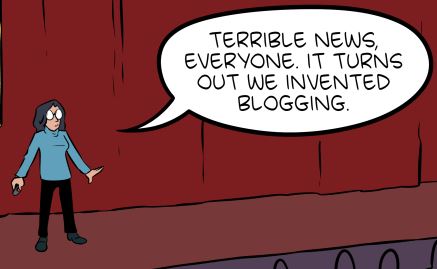Nice simple design, @typehut, but with no RSS, Atom, nor h-feed you’ve made a blog platform to which readers can only subscribe by email. 😢
Tag: blogging
Third party
This is a repost promoting content originally published elsewhere. See more things Dan's reposted.
…why would cookies ever need to work across domains? Authentication, shopping carts and all that good stuff can happen on the same domain. Third-party cookies, on the other hand, seem custom made for tracking and frankly, not much else.
…
Then there’s third-party JavaScript.
In retrospect, it seems unbelievable that third-party JavaScript is even possible. I mean, putting arbitrary code—that can then inject even more arbitrary code—onto your website? That seems like a security nightmare!
I imagine if JavaScript were being specced today, it would almost certainly be restricted to the same origin by default.
…
Jeremy hits the nail on the head with third-party cookies and Javascript: if the Web were invented today, there’s no way that these potentially privacy and security-undermining features would be on by default, globally. I’m not sure that they’d be universally blocked at the browser level as Jeremy suggests, though: the Web has always been about empowering developers, acting as a playground for experimentation, and third-party stuff does provide benefits: sharing a login across multiple subdomains, for example (which in turn can exist as a security feature, if different authors get permission to add content to those subdomains).
Instead, then, I imagine that a Web re-invented today would treat third-party content a little like we treat CORS or we’re beginning to treat resource types specified by Content-Security-Policy and Feature-Policy headers. That is, website owners would need to “opt-in” to which third-party domains could be trusted to provide content, perhaps subdivided into scripts and cookies. This wouldn’t prohibit trackers, but it would make their use less of an assumed-default (develolpers would have to truly think about the implications of what they were enabling) and more transparent: it’d be very easy for a browser to list (and optionally block, sandbox, or anonymise) third-party trackers could potentially target them, on a given site, without having to first evaluate any scripts and their sources.
I was recently inspired by Dave Rupert to remove Google Analytics from this blog. For a while, there’ll have been no third-party scripts being delivered on this site at all, except through iframes (for video embedding etc., which is different anyway because there’s significantly less scope leak). Recently, I’ve been experimenting with Jetpack because I get it for free through my new employer, but I’m always looking for ways to improve how well my site “stands alone”: you can block all third-party resources and this site should still work just fine (I wonder if I can add a feature to my service worker to allow visitors to control exactly what third party content they’re exposed to?).
Consume less, create more
This is a repost promoting content originally published elsewhere. See more things Dan's reposted.
…
Perhaps three people will read this essay, including my parents. Despite that, I feel an immense sense of accomplishment. I’ve been sitting on buses for years, but I have more to show for my last month of bus rides than the rest of that time combined.
Smartphones, I’ve decided, are not evil. This entire essay was composed on an iPhone. What’s evil is passive consumption, in all its forms.
…
This amazing essay really hammers home a major part of why I blog at all. Creating things on the Web is good. Creating things at all is good.
A side-effect of social media culture (repost, reshare, subscribe, like) is that it’s found perhaps the minimum-effort activity that humans can do that still fulfils our need to feel like we’ve participated in our society. With one tap we can pass on a meme or a funny photo or an outrageous news story. Or we can give a virtual thumbs-up or a heart on a friend’s holiday snaps, representing the entirety of our social interactions with them. We’re encouraged to create the smallest, lightest content possible: forty words into a Tweet, a picture on Instagram that we took seconds ago and might never look at again, on Facebook… whatever Facebook’s for these days. The “new ‘netiquette” is complicated.
I, for one, think it’d be a better world if it saw a greater diversity of online content. Instead of many millions of followers of each of a million content creators, wouldn’t it be nice to see mere thousands of each of billions? I don’t propose to erode the fame of those who’ve achieved Internet celebrity; but I’d love to migrate towards a culture in which we can all better support one another’s drive to create original content online. And do so ourselves.
The best time to write on your blog is… well, let’s be honest, it was a decade ago. But the second best time is right now. Or if you’d rather draw, or sing, or dance, or make puzzles or games or films… do that. The barrier to being a content creator has never been lower: publishing is basically free and virtually any digital medium is accessible from even the simplest of devices. Go make something, and share it with the world.
(with thanks to Jeremy for the reshare)
Subscribe by Email
For the last few months, I’ve been running an alpha test of an email-based subscription to DanQ.me with a handful of handpicked testers. Now, I’d like to open it up to a slightly larger beta test group. If you’d like to get the latest from this site directly in your inbox, just provide your email address below:
Subscribe by email!
Who’s this for?
Some people prefer to use their email inbox to subscribe to things. If that’s you: great!
What will I receive?
You’ll get a “daily digest”, no more than once per day, summarising everything I’ve published within the last 24 hours. It usually works: occasionally but not often it misses things. You can unsubscribe with one click at any time.
How else can I subscribe?
You can still subscribe in a variety of other ways. Personally, I recommend using a feed reader which lets you choose exactly which kinds of content you’re interested in, but there are plenty of options including Facebook and Twitter (for those of such an inclination).
Didn’t you do this before?
Yes, I ran a “subscribe by email” system back in 2007 but didn’t maintain it. Things might be better this time around. Maybe.
So You Want To Start An Unpopular Blog
This is a repost promoting content originally published elsewhere. See more things Dan's reposted.
Very occasionally I get asked how to start blogging by people who would like to create exciting and engaging articles that will build a following by delighting an audience hungry for more. Perhaps they envision spreading their views far across the face of the web.
To which I always reply, “Have you read my blog? I don’t know about any of those things!”
What I do have are 10 years of logs and some vague observations about beginning a blog.
…
As I’m sat here anyway, helping people get started on the Indieweb, here’s a great (tongue in cheek) look at
how you can expect your new blog Indieweb presence to take off and become the Most Popular Thing Ever. Or rather, not.
But as I and others have said before, my blog is first and foremost for me. If you get something out of it too, that’s great, but that’s a secondary goal!
Motorbiking to Scotland
This is a repost promoting content originally published elsewhere. See more things Dan's reposted.
…
This adventure took a lot of planning. It’s 350 miles from where I live to Glasgow. I have a Honda CG 125cc, and my maximum range in one day is around 200 miles – if I have the full day for travelling, which I wouldn’t have, most days. I figured if I was going to have a road trip, I’d have to make stop offs at various parts of the UK, to break it up. This actually worked out really well, as there are lots of parts of the UK that I wanted to visit.
…
After booking the series of hotel rooms, I started to think about the actual riding. It was two weeks before the trip. I didn’t have enough thermals, or a bike suit that was protective enough. I also didn’t have a way of storing luggage on my bike, or keeping it dry (and two laptops would be in the bags). There was also an issue with the chain on my bike that needed fixing. Not exactly a trivial to do list! So the next two weeks turned into a bit of an eBay and Amazon frenzy, with a trip down to see my dad in Kent to get the bike chain fixed, and rummage around for my old waterproofs in my grandparent’s attic. It was pretty close: the final item arrived the day before the trip. I got ridiculously lucky on eBay with my new, more visible, better padded, comfy bike suit though, which I love to bits. In hindsight, more time for all of this would have been helpful!
…
My friend Bev wrote about their motorcycling adventure up and down the UK; it’s pretty awesome.
DanQ.me Ecosystem
With IndieWebCamp Oxford 2019 scheduled to take place during the Summer of Hacks, I drew a diagram (click to embiggen) of the current ecosystem that powers and propogates the content on DanQ.me. It’s mostly for my own benefit – to be able to get a big-picture view of the ways my website talks to the world and plan for what improvements I might be able to make in the future… but it also works as a vehicle to explain what my personal corner of the IndieWeb does and how it does it. Here’s a summary:
DanQ.me
Since fifteen years ago today, DanQ.me has been powered by a self-hosted WordPress installation. I know that WordPress isn’t “hip” on the IndieWeb this week and that if you’re not on the JAMstack you’re yesterday’s news, but at 15 years and counting my love affair with WordPress has lasted longer than any romantic relationship I’ve ever had with another human being, so I’m sticking with it. What’s cool in Web technologies comes and goes, but what’s important is solid, dependable tools that do what you need them to, and between WordPress, half a dozen off-the-shelf plugins and about a dozen homemade ones I’ve got everything I need right here.
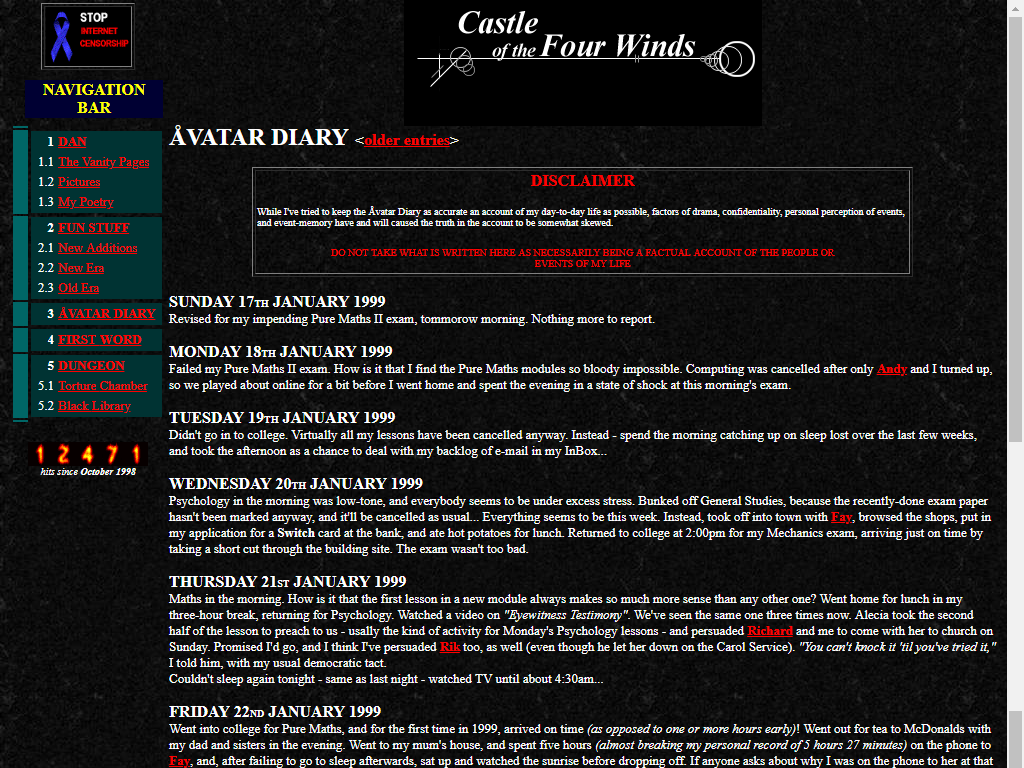
I write articles (long posts like this) and notes (short, “tweet-like” updates) directly into the site, and just occasionally other kinds of content. But for the most part, different kinds of content come from different parts of the ecosystem, as described below.
RSS reader
DanQ.me sits at the centre of the diagram, but it’s worth remembering that the diagram is deliberately incomplete: it only contains information flows directly relevant to my blog (and it doesn’t even contain all of those!). The last time I tried to draw a diagram like this that described my online life in general, then my RSS reader found its way to the centre. Which figures: my RSS reader is usually the first and often the last place I visit on the Internet, and I’ve worked hard to funnel everything through it.
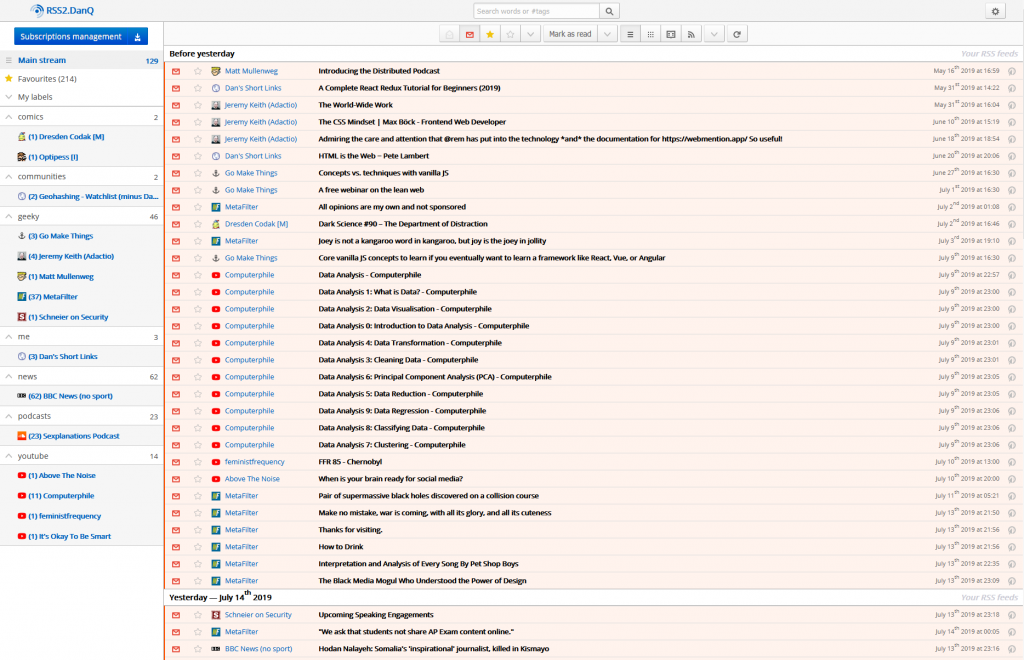
Right now I’m using FreshRSS – plus a handful of plugins, including some homemade ones – as my RSS reader: I switched from Tiny Tiny RSS about a year ago to take advantage of FreshRSS’s excellent responsive themes, among other features. Because some websites don’t have RSS feeds, even where they ought to, I use my own tool RSSey to retroactively “fix” people’s websites for them, dynamically adding feeds for my consumption. It’s also a nice reminder that open source and remixability were cornerstones of the original Web. My RSS reader collates information from a variety of sources and additionally gives me a one-click mechanism to push content I enjoy to my blog as a repost.
QTube
QTube is my video hosting platform; it’s a PeerTube node. If you haven’t seen it, that’s fine: most content on it is consumed indirectly either through my YouTube channel or directly on my blog as posts of the “video” kind. Also, I don’t actually vlog very often. When I do publish videos onto QTube, their republication onto YouTube or DanQ.me is optional: sometimes I plan to use a video inside an article post, for example, and so don’t need to republish it by itself.
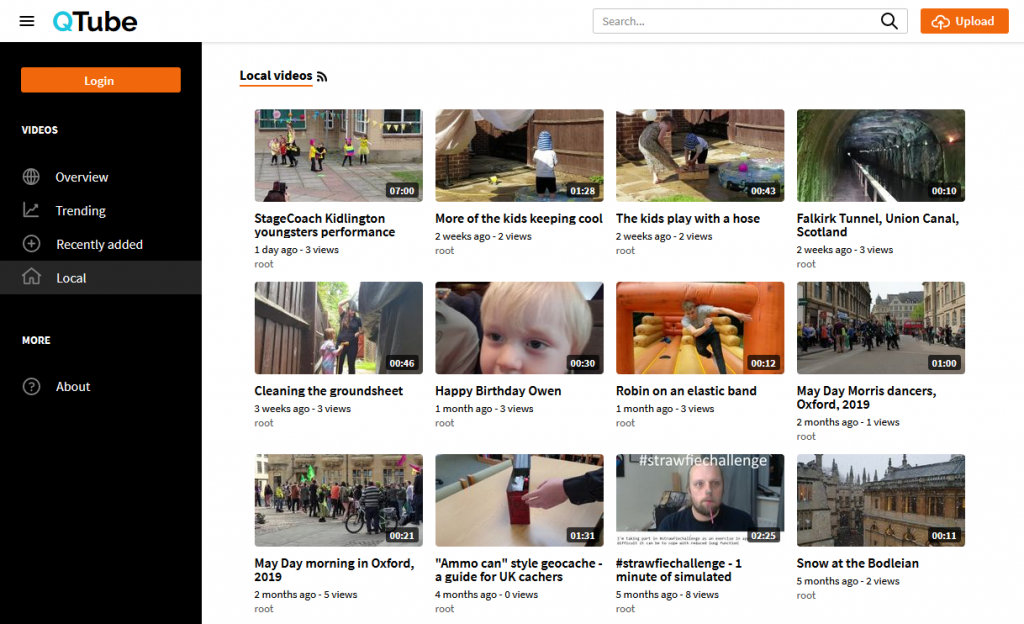
I’m gradually exporting or re-uploading my backlog of YouTube videos from my current and previous channels to QTube in an effort to recentralise and regain control over their hosting, but I’m in no real hurry. PeerTube certainly makes it easy, though!
Link Shortener
I operate a private link shortener which I mostly use for the expected purpose: to make links shorter and so easier to read out and memorise or else to make them take up less space in a chat window. But soon after I set it up, many years ago, I realised that it could also act as a mechanism to push content to my RSS reader to “read later”. And by the time I’m using it for that, I figured, I might as well also be using it to repost content to my blog from sources that aren’t things my RSS reader subscribes to. This leads to a process that’s perhaps unnecessarily complex: if I want to share a link with you as a repost, I’ll push it into my link shortener and mark it as going “to me”, then I’ll tell my RSS reader to push it to my blog and there it’ll be published to the world! But it works and it’s fast enough: I’m not in the habit of reposting things that are time-critical anyway.
Checkins
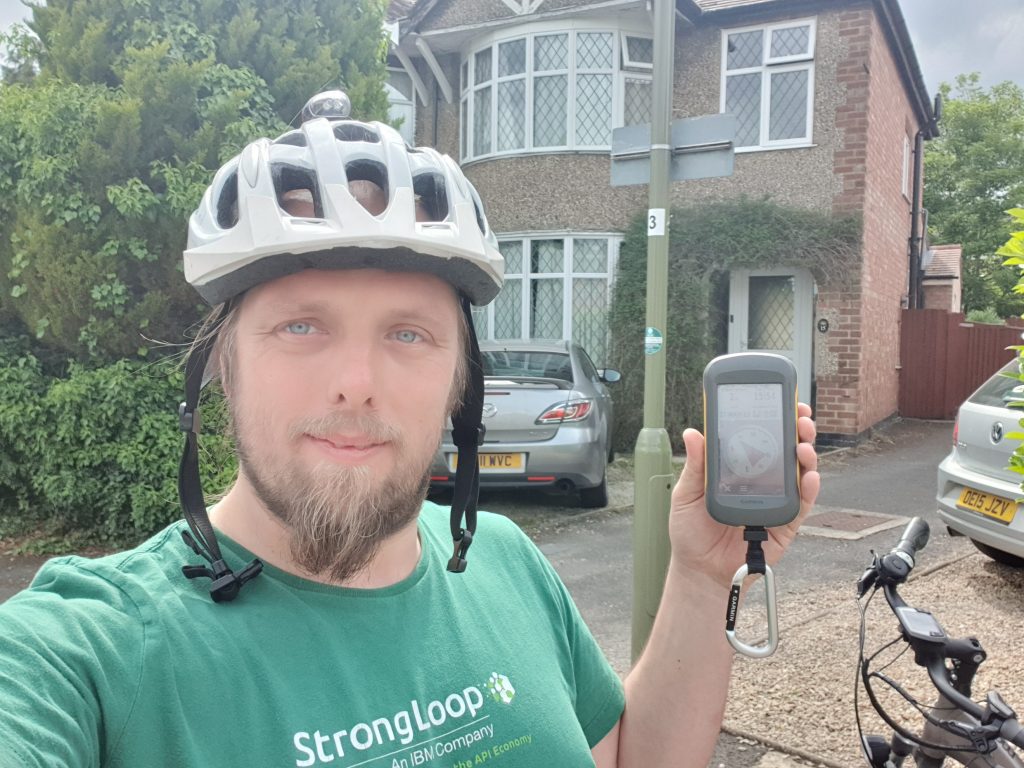
I’ve been involved in brainstorming ways in which the act of finding (or failing to find, etc.) a geocache or reaching (or failing to reach) a geohashpoint could best be represented as a “checkin“, and last year I open-sourced my plugin for pulling logs (with as much automation as is permitted by the terms of service of some of the silos involved) from geocaching websites and posting them to WordPress blogs: effectively PESOS-for-geocaching. I’d prefer to be publishing on my own blog in the first instance, but syndicating my adventures from various silos into my blog is “good enough”.
Syndication
New notes get pushed out to my Twitter account, for the benefit of my Twitter-using friends. Articles get advertised on Facebook, Twitter and LiveJournal (yes, really) in teaser form, for the benefit of friends who prefer to get notifications via those platforms. Facebook have been fucking around with their APIs and terms of service lately and this is now less-automatic than it used to be, which is a bit of an annoyance. My RSS feeds carry copies of content out to people who prefer to subscribe via that medium, and I’ve also been using this to power an experimental MailChimp “daily digest” mailing list of “what Dan’s been up to” to a small number of friends, right in their email inboxes: I’ve not made it available to everybody yet, but if you’re happy to help test it then give me a shout and I’ll hook you up.
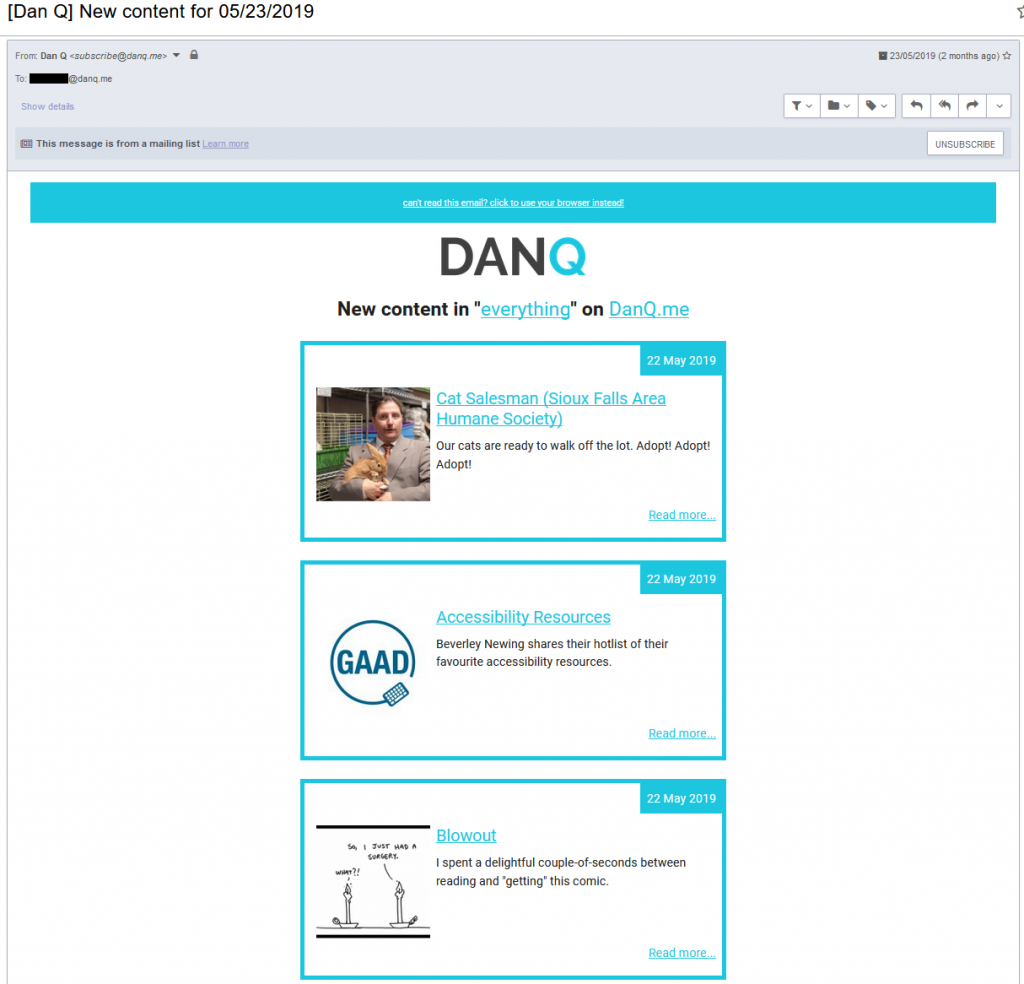
Finally, a couple of IFTTT recipes push my articles and my reposts to Reddit communities: I don’t really use Reddit myself, any more, but I’ve got friends in a few places there who prefer to keep up-to-date with what I’m up to via that medium. For historical reasons, my reposts to Reddit don’t go directly via my blog’s RSS feeds but “shortcut” directly from my RSS reader: this is suboptimal because I don’t get to tweak post titles for Reddit but it’s not a big deal.
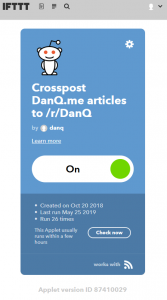
I used to syndicate content to Google+ (before it joined the long list of Things Google Have Killed) and to Ello (but it never got much traction there). I’ve probably historically syndicated to other places too: I’ve certainly manually-republished content to other blogs, from time to time, too.
Backfeed
I use Ryan Barrett‘s excellent Brid.gy to convert Twitter replies and likes back into Webmentions for publication as comments on my blog. This used to work for Facebook, too, but again: Facebook fucked it over. I’ve occasionally manually backfed significant Facebook comments, but it’s not ideal: I might like to look at using similar technologies to RSSey to subvert Facebook’s limitations.
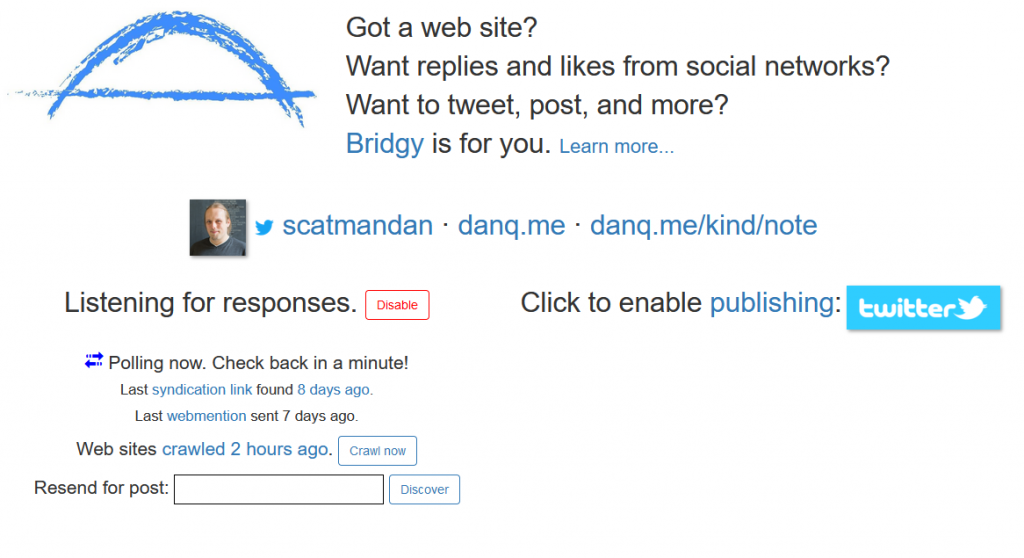
Reintegration
I’ve routinely retroactively reintegrated content that I’ve produced elsewhere on the Web. This includes my previous blogs (which is why you can browse my archives, right here on this site, all the way back to some of the cringeworthy angsty-teenager posts I made in the 1990s) but also some Reddit posts, some replies originally posted directly to other people’s blogs, all my old del.icio.us bookmarks, long-form forum posts, posts I made to mailing lists and newsgroups, and more. As a result, there’s a lot of backdated content on this site, nowadays: almost a million words, and significantly more than the 600,000 or so I counted a few years ago, before my biggest push for reintegration!

Why do I do this? Because I really, really like owning my identity online! I’ve tried the “big” silo alternatives like Facebook, Twitter, Medium, Instagram etc., and they’ve eventually always lead to disappointment, either because they get shut down or otherwise made-unusable, because of inappropriately-applied “real names” policies, because they give too much power to untrustworthy companies, because they impose arbitrary limitations on my content, because they manipulate output promotion (and exacerbate filter bubbles), or because they make the walls of their walled gardens taller and stop you integrating with them how you used to.
A handful of silos have shown themselves to be more-trustworthy than the average – in particular, eschewing techniques that promote “lock-in” – and I’d love to tell you more about them and what I think you should look for in a silo, another time. But for now: suffice to say that just like I don’t use YouTube like most people do, I elect not to use Facebook or Twitter in the conventional ways either. And it’s awesome, thanks.
There are plenty of reasons that people choose to take control of their own Web presence – and everybody who puts content online ought to consider it – but I imagine that few individuals have such a complicated publishing ecosystem as I do! Now you’ve got a picture of how my digital content production workflow works, and perhaps start owning your online identity, too.
Permission to Write Stuff
This is a repost promoting content originally published elsewhere. See more things Dan's reposted.
…
I would say treat the web like that big red button of the original Flip camera. Just push it, write something and then publish it. It may not be perfect, but nothing ever is anyway. I write all sorts of crap on my blog — some of it really niche like snippets for Vim. Yet it’s out there just in case someone finds it useful at some point — not least me when I forget how I’ve done something.
…
I write all kinds of crap on my blog, too, and for mostly the same reasons: my blog is for me, first and foremost. Hopefully others, from time to time, find it interesting or useful, but I can’t in good faith argue that I keep the shit I wrote in the 90s or early 2000s here for the benefit of the Internet as a whole! It’s for me first.
Good analogy with the Flip camera (follow the link through to Brendan’s post for the full explanation).
Blogging with semantic insertions and deletions
When I write a blog post, it generally becomes a static thing: its content always
usually stays the same for the rest of its life (which is, in my case, pretty much forever). But sometimes, I go back and make an
amendment. When I make minor changes that don’t affect the overall meaning of the work, like fixing spelling mistakes and repointing broken links, I just edit the page, but for
more-significant changes I try to make it clear what’s changed and how.

Historically, I’d usually marked up deletions with the HTML <strike>/<s> elements (or
other visually-similar approaches) and insertions by clearly stating that a change had been made (usually accompanied by the date and/or time of the change), but this isn’t a good
example of semantic code. It also introduces an ambiguity when it clashes with the times I use <s> for comedic effect in the Web equivalent of the old caret-notation joke:
Be nice to this fool^H^H^H^Hgentleman, he's visiting from corporate HQ.
Better, then, to use the <ins> and <del> elements, which were designed for exactly this purpose and even accept attributes to specify the date/time
of the modification and to cite a resource that explains the change, e.g. <ins datetime="2019-05-03T09:00:00+00:00"
cite="https://alices-blog.example.com/2019/05/03/speaking.html">The last speaker slot has now been filled; thanks Alice</ins>. I’ve worked to retroactively add such
semantic markup to my historical posts where possible, but it’ll be an easier task going forwards.
Of course, no browser I’m aware of supports these attributes, which is a pity because the metadata they hold may well have value to a reader. In order to expose them I’ve added a little bit of CSS that looks a little like this, which makes their details (where available) visible as a sort-of tooltip when hovering over or tapping on an affected area. Give it a go with the edits at the top of this post!
ins[datetime], del[datetime] { position: relative; } ins[datetime]::before, del[datetime]::before { position: absolute; top: -24px; font-size: 12px; color: #fff; border-radius: 4px; padding: 2px 6px; opacity: 0; transition: opacity 0.25s; hyphens: none; /* suppresses sitewide line break hyphenation rules */ white-space: nowrap; /* suppresses extraneous line breaks in Chrome */ } ins[datetime]:hover::before, del[datetime]:hover::before { opacity: 0.75; } ins[datetime]::before { content: 'inserted ' attr(datetime) ' ' attr(cite); background: #050; /* insertions are white-on-green */ } del[datetime]::before { content: 'deleted ' attr(datetime) ' ' attr(cite); background: #500; /* deletions are white-on-red */ }
<ins>/<del> datetimes and citations on hover or touch.
I’m aware that the intended use-case of <ins>/<del> is change management, and that the expectation is that the “final” version of a
document wouldn’t be expected to show all of the changes that had been made to it. Such a thing could be simulated, I suppose, by appropriately hiding and styling the
<ins>/<del> blocks on the client-side, and that’s something I might look into in future, but in practice my edits are typically small and rare
enough that nobody would feel inconvenienced by their inclusion/highlighting: after all, nobody’s complained so far and I’ve been doing exactly that, albeit in a non-semantic way, for
many years!
I’m also slightly conscious that my approach to the “tooltip” might cause it to obstruct interactivity with something directly above an insertion or deletion: e.g. making a hyperlink inaccessible. I’ve tested with a variety of browsers and devices and it doesn’t seem to happen (my line height works in my favour) but it’s something I’ll need to be mindful of if I change my typographic design significantly in the future.
A final observation: I love the CSS attr() function, and I’ve been using it (and counter()) for all
kinds of interesting things lately, but it annoys me that I can only use it in a content: statement. It’d be amazingly valuable to be able to treat integer-like attribute
values as integers and combine it with a calc() in order to facilitate more-dynamic styling of arbitrary sets of HTML elements. Maybe one day…
For the time being, I’m happy enough with my new insertion/deletion markers. If you’d like to see them in use in their natural environment, see the final paragraph of my 2012 review of The Signal and The Noise.
Regarding the Thoughtful Cultivation of the Archived Internet
This is a repost promoting content originally published elsewhere. See more things Dan's reposted.
…
With 20+ years of kottke.org archives, I’ve been thinking about this issue [continuing to host old content that no longer reflects its authors views] as well. There are many posts in the archive that I am not proud of. I’ve changed my mind in some cases and no longer hold the views attributed to me in my own words. I was too frequently a young and impatient asshole, full of himself and knowing it all. I was unaware of my privilege and too frequently assumed things of other people and groups that were incorrect and insensitive. I’ve amplified people and ideas in the past that I wouldn’t today.
…
Very much this! As another blogger with a 20+ year archive, I often find myself wondering how much of an impression of me is made upon my readers by some of my older posts, and what it means to retain them versus the possibility – never yet exercised – of deleting them. I certainly have my fair share of posts that don’t represent me well or that are frankly embarrassing, in hindsight!
I was thinking about this recently while following a thread on BoardGameGeek in which a poster advocated for the deletion of a controversial article from the site because, as they said:
…people who stumble on our site and see this game listed could get a very (!!!) bad impression of the hobby…
This is a similar concern: a member of an online community is concerned that a particular piece of archived content does not reflect well on them. They don’t see any way in which the content can be “fixed”, and so they propose that it is removed from the community. Parallels can be drawn to the deletionist faction within Wikipedia (if you didn’t know that Wikipedia had large-scale philosophical disputes before now, you’re welcome: now go down the meta-wiki rabbit hole).
As for my own blog, I fall on the side of retention: it’s impossible to completely “hide” my past by self-censorship anyway as there’s sufficient archives and metadata to reconstruct it, and moreover it feels dishonest to try. Instead, though, I do occasionally append rebuttals to older content – where I’ve time! – to help contextualise them and show that they’re outdated. I’ve even considered partially automating this by e.g. adding a “tag” that I can rapidly apply to older posts that haven’t aged well which would in turn add a disclaimer to the top of them.
Cool URIs don’t change. But the content behind them can. The fundamental message ought to be preserved, where possible, and so appending and retaining history seems to be a more-valid approach than wholesale deletion.
Fixing Social Media
This is a repost promoting content originally published elsewhere. See more things Dan's reposted.
Still Blogging in 2017
This is a repost promoting content originally published elsewhere. See more things Dan's reposted.
…
On a blog, I can write about blogging and whimsically toss in self-indulgent pictures of May’s budding azaleas.
I can end my career, right here, in a flash. I can rant about the perfidy and corruption of my local governing party, who I devoutly hope are about to be turfed by the voters. I can discuss the difference between O(1) and O(log(N)), which can usually be safely ignored.
On blogs, I can read most of the long-form writing that’s worth reading about the art and craft of programming computers. Or I can follow most of the economists’ debates that are worth having. Or I can check out a new photographer every day and see new a way of seeing the world.
Having said that, it seems sad that most of the traffic these days goes to BigPubs. That the advertising dollars are being sucked inexorably into Facebook/Google and away from anyone else. That these days, I feel good over a piece that gets more than twenty thousand reads (only one so far this year).
…
When I wrote about 20 years of blogging, this was the kind of thing I meant when I talked about why it’s important, to me. But Tim says it better.
20 Years Of Blogging
As of next week, I’ll have been blogging for 20 years, or about 54% of my life. How did that happen?
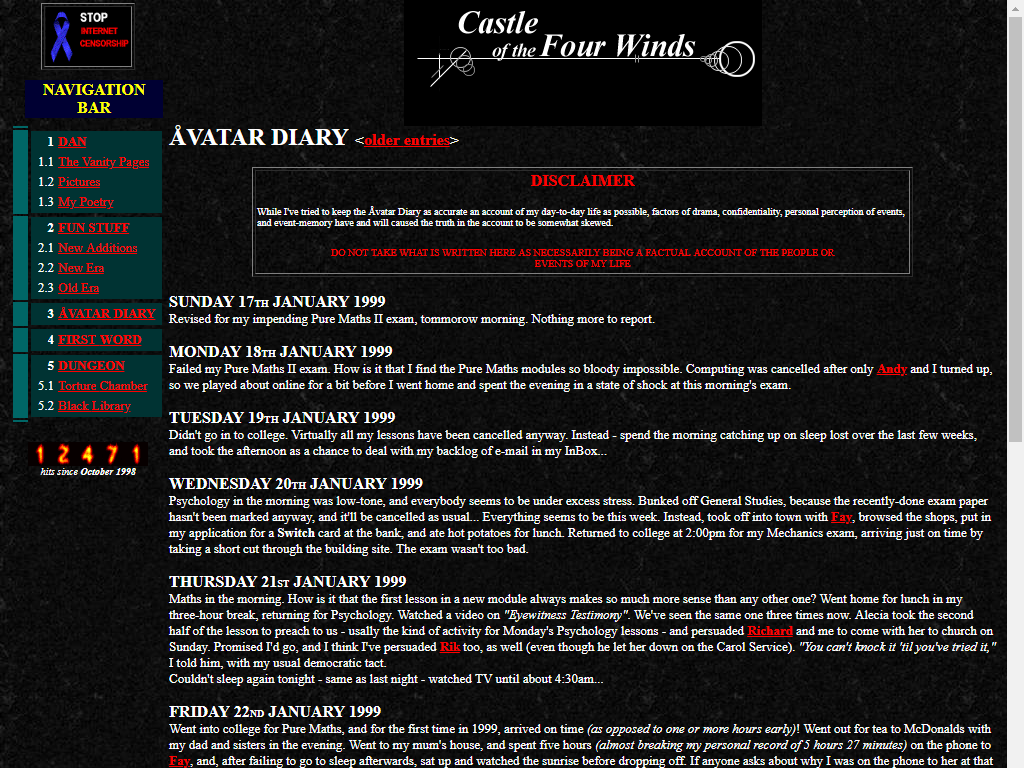
The mid-1990s were a very different time for the World Wide Web (yes, we still called it that, and sometimes we even described its use as “surfing”). Going “on the Internet” was a calculated and deliberate action requiring tying up your phone line, minutes of “connecting” along with all of the associated screeching sounds if you hadn’t turned off your modem’s loudspeaker, and you’d typically be paying twice for the experience: both a monthly fee to your ISP for the service and a per-minute charge to your phone company for the call.
It was into this environment that in 1994 I published my first web pages: as far as I know, nothing remains of them now. It wasn’t until 1998 that I signed up an account with UserActive (whose website looks almost the same today as it did then) who offered economical subdomain hosting with shell and CGI support and launched “Castle of the Four Winds”, a set of vanity pages that included my first blog.
Except I didn’t call it a “blog”, of course, because it wasn’t until the following year that Peter Merholz invented the word (he also commemorated 20 years of blogging, this year). I didn’t even call it a “weblog”, because that word was still relatively new and I wasn’t hip enough to be around people who said it, yet. It was self-described as an “online diary”, a name which only served to reinforce the notion that I was writing principally for myself. In fact, it wasn’t until mid-1999 that I discovered that it was being more-widely read than just by me and my circle of friends when I attracted a stalker who travelled across the UK to try to “surprise” me by turning up at places she expected to find me, based on what I’d written online… which was exactly as creepy as it sounds.
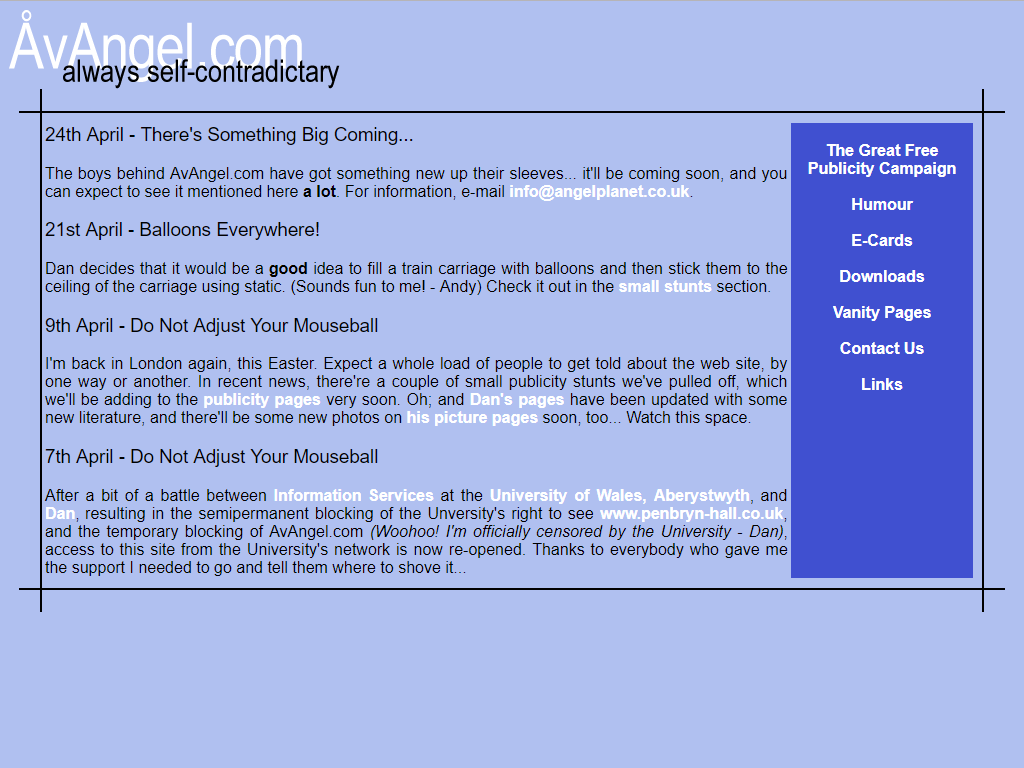
While the world began to panic that the coming millennium was going to break all of the computers, I migrated Castle of the Four Winds’ content into AvAngel.com, a joint vanity site venture with my friend Andy. Aside from its additional content (purity tests, funny stuff, risqué e-cards), what we hosted was mostly the same old stuff, and I continued to write snippets about my life in what was now quite-clearly a “blog-like” format, with the most-recent posts at the top and separate pages for content too old for the front page. Looking back, there’s still a certain naivety to these posts which exemplify the youth of the Web. For example, posts routinely referenced my friends by their email addresses, because spam was yet to become a big enough problem that people didn’t much mind if you put their email address on a public webpage somewhere, and because email addresses still carried with them a feeling of anonymity that ceased to be the case when we started using them for important things.
Technologically-speaking, too, this was a simpler time. Neither Javascript nor CSS support was widespread (nor consistently-standardised) enough to rely upon for anything other than the simplest progressive enhancement unless you were willing to “pick a side” in what we’d subsequently call the first browser war and put one of those apalling “best viewed in Internet Explorer” or “best viewed in Netscape Navigator” banners on your site. I’ve always been a believer in a universal web (and my primary browser at the time was Opera, anyway, as it mostly-remained until Opera went wrong in 2013), and I didn’t have the energy to write everything twice, so our cool/dynamic functionality came mostly from back-end (e.g. Perl, PHP) technologies.
Meanwhile, during my initial months as a student in Aberystwyth, I wrote a series of emails to friends back home entitled “Cool And Interesting Thing Of The Day To Do At The University Of Wales, Aberystwyth”, and put copies of each onto my student webspace; I’ve since recovered these and integrated them into my unified blog.
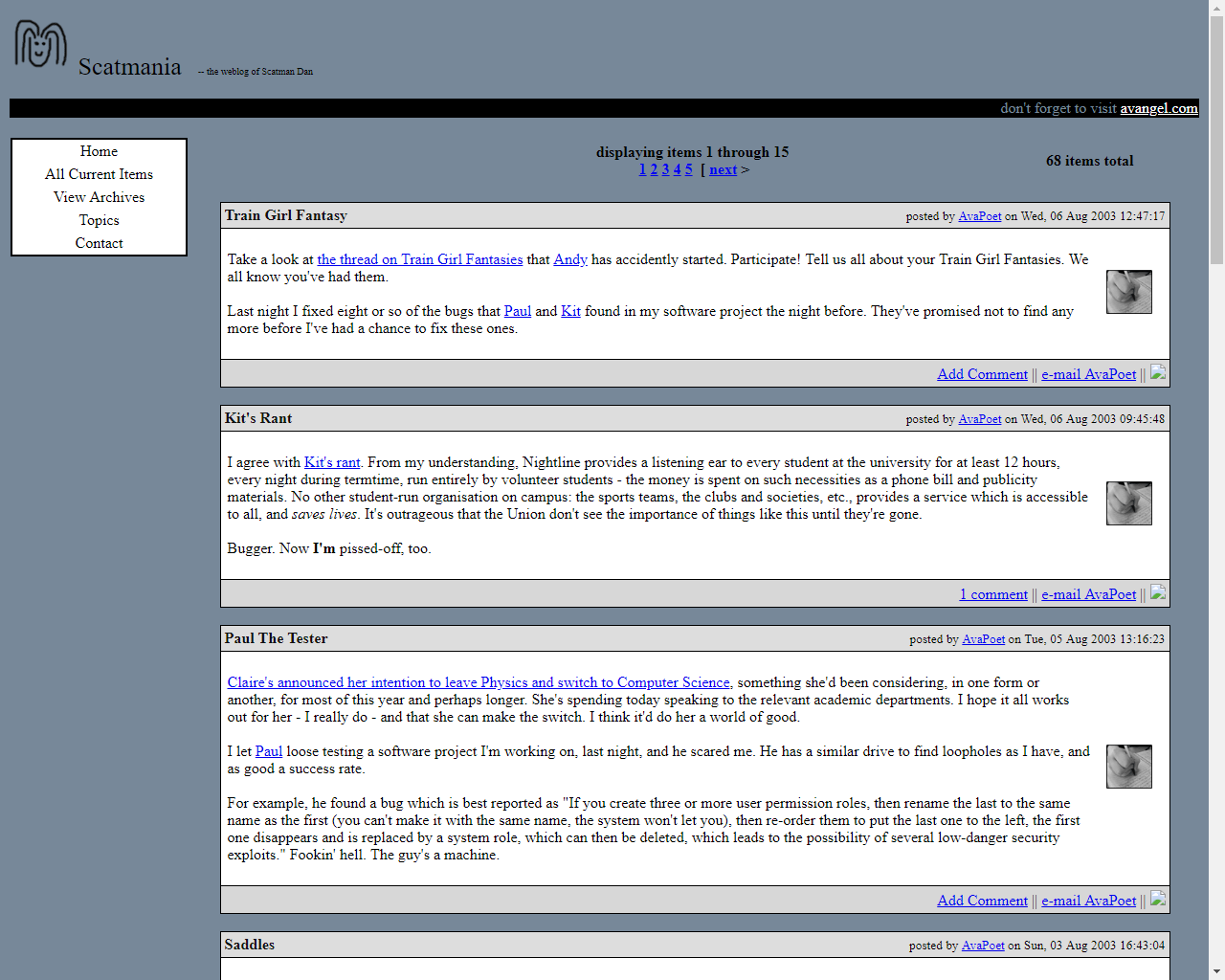
In 2002 I’d bought the domain name scatmania.org – a reference to my university halls of residence nickname “Scatman Dan”; I genuinely didn’t consider the possibility that the name might be considered scatalogical until later on. As I wanted to continue my blogging at an address that felt like it was solely mine (AvAngel.com having been originally shared with a friend, although in practice over time it became associated only with me), this seemed like a good domain upon which to relaunch. And so, in mid-2003 and powered by a short-lived and ill-fated blogging engine called Flip I did exactly that. WordPress, to which I’d subsequently migrate, hadn’t been invented yet and it wasn’t clear whether its predecessor, b2/cafelog, would survive the troubles its author was experiencing.
From this point on, any web address for any post made to my blog still works to this day, despite multiple technological and infrastructural changes to my blog (and some domain name shenanigans!) in the meantime. I’d come to be a big believer in the mantra that cool URIs don’t change: something that as far as possible I’ve committed to trying to upload in my blogging, my archiving, and my paid work since then. I’m moderately confident that all extant links on the web that point to earlier posts are all under my control so they can (and in most cases have) been fixed already, so I’m pretty close to having all my permalink URIs be “cool”, for now. You might hit a short chain of redirects, but you’ll get to where you’re going.
And everything was fine, until one day in 2004 when it wasn’t. The server hosting scatmania.org died in a very bad way, and because my backup strategy was woefully inadequate, I lost a lot of content. I’ve recovered quite a lot of it and put it back in-place, but some is probably gone forever.

The resurrected site was powered by WordPress, and this was the first time that live database queries had been used to power my blog. Occasionally, these days, when talking to younger, cooler developers, I’m tempted to follow the hip trend of reimplementing my blog as a static site, compiling a stack of host-anywhere HTML files based upon whatever-structure-I-like at the “backend”… but then I remember that I basically did that already for six years and I’m far happier with my web presence today. I’ve nothing against static site systems (I’m quite partial to Middleman, myself, although I’m also fond of Hugo) but they’re not right for this site, right now.
IndieAuth hadn’t been invented yet, but I was quite keen on the ideals of OpenID (I still am, really), and so I implemented what was probably the first viable “install-anywhere” implementation of OpenID for WordPress – you can see part of it functioning in the top-right of the screenshot above, where my (copious, at that time) LiveJournal-using friends were encouraged to sign in to my blog using their LiveJournal identity. Nowadays, the majority of the WordPress plugins I use are ones I’ve written myself: my blog is powered by a CMS that’s more “mine” than not!

Over the course of the first decade of my blogging, a few trends had become apparent in my technical choices. For example:
- I’ve always self-hosted my blog, rather than relying on a “blog as a service” or siloed social media platform like WordPress.com, Blogger, or LiveJournal.
- I’ve preferred an approach of storing the “master” copy of my content on my own site and then (sometimes) syndicating it elsewhere: for example, for the benefit of my friends who during their University years maintained a LiveJournal, for many years I had my blog cross-post to a LiveJournal account (and backfeed copies of comments back to my site).
- I’ve favoured web standards that provided maximum interoperability (e.g. RSS with full content) and longevity (serving HTML pages from permanent URLs, adding “extra” functionality via progressive enhancement so as to ensure that content functioned e.g. without Javascript, with CSS disabled or the specification evolved, etc.).
These were deliberate choices, but they didn’t require much consideration: growing up with a Web far less-sophisticated than today’s (e.g. truly stateless prior to the advent of HTTP cookies) and seeing the chaos caused during the first browser war and the period of stagnation that followed, these choices seemed intuitive.
(Perhaps it’s not so much of a coincidence that I’ve found myself working at a library: maybe I’ve secretly been a hobbyist archivist all along!)

As you’d expect from a blog covering a period from somebody’s teen years through to their late thirties, there’ve been significant changes in the kinds of content I’ve posted (and the tone with which I’ve done so) over the years, too. If you dip into 2003, for example, you’ll see the results of quiz memes and unqualified daily minutiae alongside actual considered content. Go back further, to early 1999, and it is (at best) meaningless wittering about the day-to-day life of a teenage student. It took until around 2009/2010 before I actually started focussing on writing content that specifically might be enjoyable for others to read (even where that content was frankly silly) and only far more-recently-still that I’ve committed to the “mostly technical stuff, ocassional bits of ‘life’ stuff” focus that I have today.
I say “committed”, but of course I’m fully aware that whatever this blog is now, it’ll doubtless be something somewhat different if I’m still writing it in another two decades…
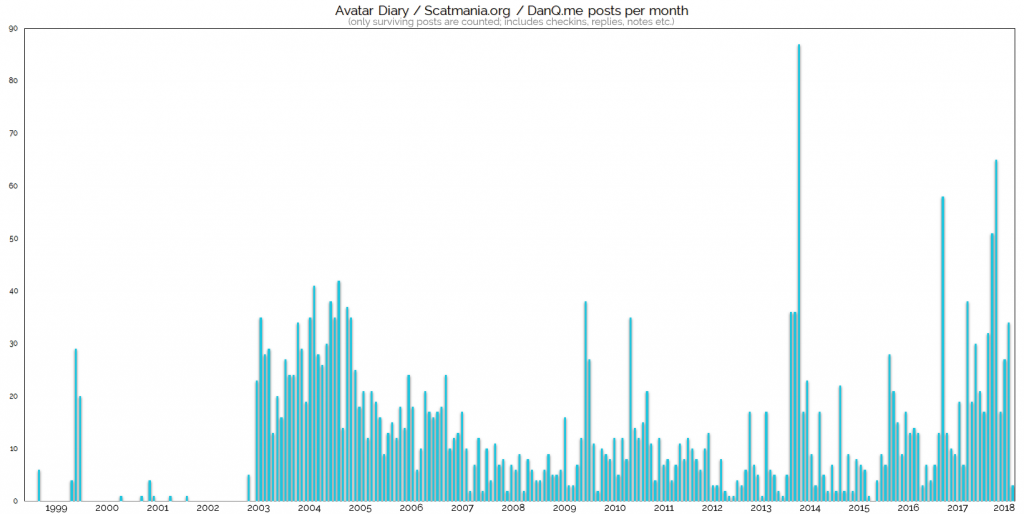
Once I reached the 2010s I started actually taking the time to think about the design of my blog and its meaning. Conceptually, all of my content is data-driven: database tables full of different “kinds” of content and associated metadata, and that’s pretty-much ideal – it provides a strong separation between content and presentation and makes it possible to make significant design changes with less work than might otherwise be expected. I’ve also always generally favoured a separation of concerns in web development and so I’m not a fan of CSS design methodologies that encourage class names describing how things should appear, like Atomic CSS. Even where it results in a performance hit, I’d far rather use CSS classes to describe what things are or represent. The single biggest problem with this approach, to my mind, is that it violates the DRY principle… but that’s something that your CSS preprocessor’s there to fix for you, isn’t it?
But despite this philosophical outlook on the appropriate gap between content and presentation, it took until about 2010 before I actually attached any real significance to the presentation at all! Until this point, I’d considered myself to have been more of a back-end than a front-end engineer, and felt that the most-important thing was to get the content out there via an appropriate medium. After all, a site without content isn’t a site at all, but a site without design is (or at least should be) still intelligible thanks to browser defaults! Remember, again, that I started web development at a time when stylesheets didn’t exist at all.
My previous implementations of my blog design had used simple designs, often adapted from open-source templates, in an effort to get them deployed as quickly as possible and move on to the next task, but now, I felt, it was time to do a little more.
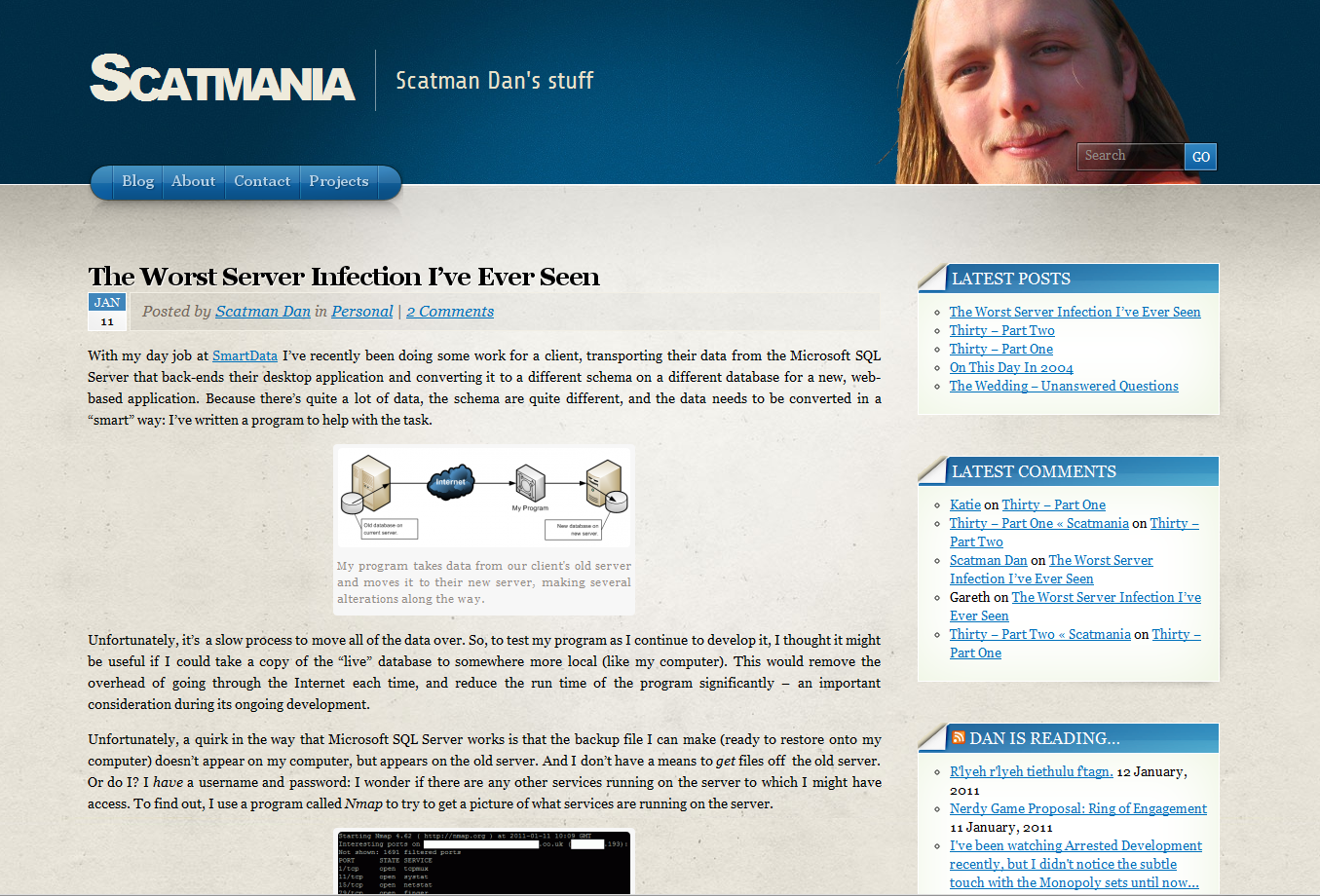
For a few years, I was producing a new theme once per year. I experimented with different colours, fonts, and layouts, and decided (after some ad-hoc A/B testing) that my audience was better-served by a “front” page than by being dropped directly into my blog archives as had previously been the case. Highlighting the latest few – and especially the very-latest – post and other recent content increased the number of posts that a visitor would be likely to engage with in a single visit. I’ve always presumed that the reason for this is that regular (but non-subscribing) readers are more-likely to be able to work out what they have and haven’t read already from summary text than from trying to decipher an entire post: possibly because my blogging had (has!) become rather verbose.
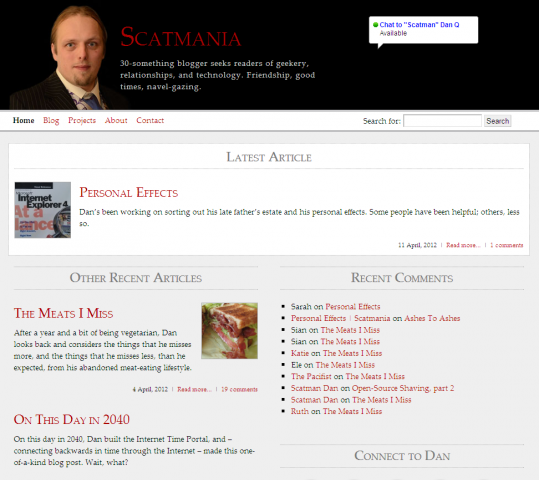
I went through a bit of a lull in blogging: I’ve joked that I spent more time on my 2010 and 2011 designs than I did on the sum total of the content that was published in between the pair of them (which isn’t true… at least, not quite!). In the month I left Aberystwyth for Oxford, for example, I was doing all kinds of exciting and new things… and yet I only wrote a total of two blog posts.
With RSS waning in popularity – which I can’t understand: RSS is amazing! – I began to crosspost to social networks like Twitter and Google+ (although no longer to Google+, following the news of its imminent demise) to help those readers who prefer to get their content via these media, but because I wasn’t producing much content, it probably didn’t make a significant difference anyway: the chance of a regular reader “missing” something must have been remarkably slim.
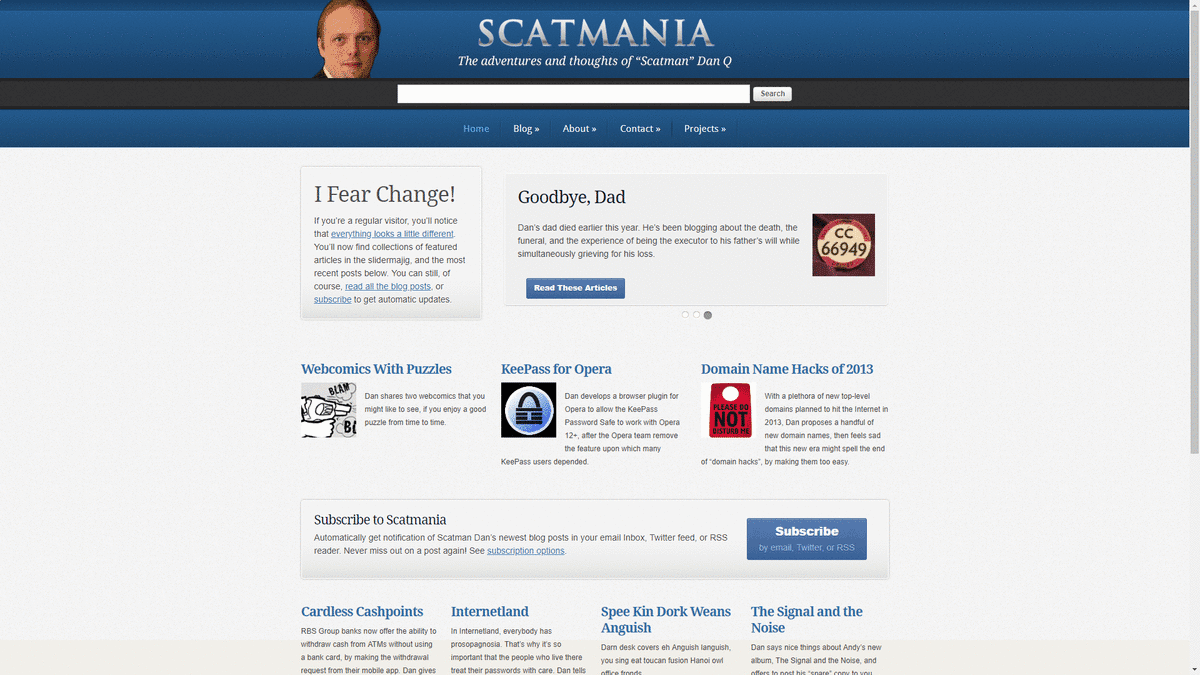
Nobody calls me “Scatman Dan” any more, and hadn’t for a long, long time. Given that my name is already awesome and unique all by itself (having changed to be so during the era in which scatmania.org was my primary personal domain name), it felt like I had the opportunity to rebrand.
I moved my blog to a new domain, DanQ.me (which is nice and short, too) and came up with a new collection of colours, fonts, and layout choices that I felt better-reflected my identity… and the fact that my blog was becoming less a place to record the mundane details of my daily life and more a place where I talk about (principally-web) technology, security, and GPS games… and just occasionally about other topics like breadmaking and books. Also, it gave me a chance to get on top of the current trend in web design for big, clean, empty spaces, square corners, and using pictures as the hook to a story.
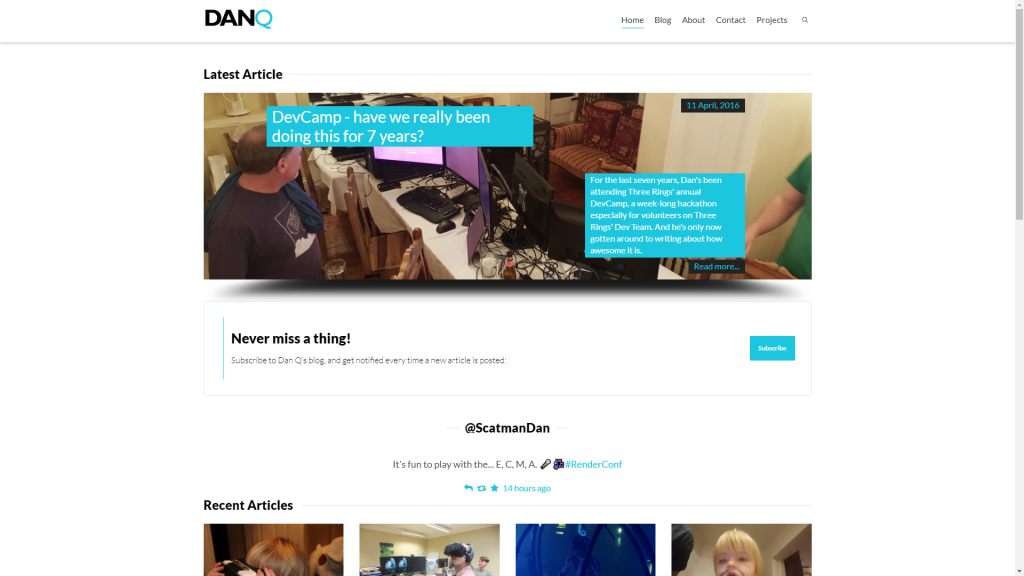
I’ve been working harder this last year or two to re-integrate (in a PESOS-like way) into my blog content that I’ve published elsewhere, mostly geocaching logs and geohashing expedition records, and I’ve also done so retroactively, so in addition to my first blog article on the subject of geocaching, you can read my first ever cache log without switching to a different site nor relying upon the continued existence and accessibility of that site. I’ve been working at being increasingly mindful of where my content is siloed outside of my control and reclaiming it by hosting it here, on my blog.
Particular areas in which I produce content elsewhere but would like to at-least maintain a copy here, and would ideally publish here first and syndicate elsewhere, although I appreciate that this is difficult, are:
- GPS games like geocaching and geohashing – I’ve mostly got this under control, but could enjoy streamlining the process or pushing towards POSSE
- Reddit, where I’ve written tens of thousands of words under a variety of accounts, but I don’t really pay attention to the site any more
- I left Facebook in 2011 but I still have a backup of what was on my “Wall” at that point, which I could look into reintegrating into my blog
- I share a lot of the source code I write via my GitHub account, but I’m painfully aware that this is yet-another-silo that I ought to learn not to depend upon (and it ought to be simple enough to mirror my repos on my own site!)
- I’ve got a reasonable number of videos on two YouTube channels which are online by Google’s good graces (and potential for advertising revenue); for a handful of technical reasons they’re a bit of a pain to self-host, but perhaps my blog could act as a secondary source to my own video content
- I write business reviews on Google Maps which I should probably look into recovering from the hivemind and hosting here… in fact, I’ve probably written plenty of reviews on other sites, too, like Amazon for example…
- On two previous occasions I’ve maintained an online photo gallery; I might someday resurrect the concept, at least for the photos that used to be published on them
- I’ve dabbled on a handful of other, often weirder, social networks before like Scuttlebutt (which has a genius concept, by the way) and Ello, and ought to check if there’s anything “original” on there I should reintegrate
- Going way, way back, there are a good number of usenet postings I’ve made over the last twenty-something years that I could reclaim, if I can find them…
(if you’re asking why I’m inclined to do all of these things: here’s why)
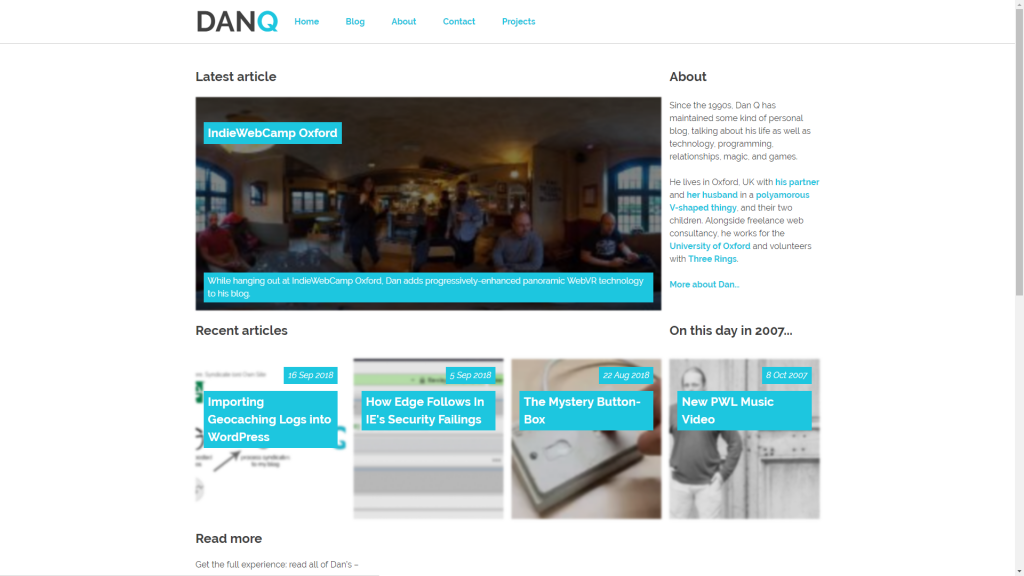
20 years and around 717,000 words worth of blogging down, it’s interesting to look back and see how things have changed: in my life, on the Web, and in the world in general. I’ve seen many friends’ blogs come and go: they move into a new phase of their life and don’t feel like what they wrote before reflects them today, most often, and so they delete them… which is fine, of course: it’s their content! But for me it’s always felt wrong to do so, for two reasons: firstly, it feels false to do so given that once something’s been put on the Web, it might well be online forever – you can’t put the genie back in the bottle! And secondly: for me, it’s valuable to own everything I wrote before. Even the cringeworthy things I wrote as a teenager who thought they knew everything and the antagonistic stuff I wrote in my early 20s but that I clearly wouldn’t stand by today is part of my history, and hiding that would be a disservice to myself.
The 17-year-old who wrote my first blog posts two decades ago this month fully expected that the things he wrote would be online forever, and I don’t intend to take that away from him. I’m sure that when I write a post in October 2038 looking back on the next two decades, I’ll roll my eyes at myself today, too, but for me: that’s part of the joy of a long-running personal blog. It’s like a diary, but with a sense of accountability. It’s a space on the web that’s “mine” into which I can dump pretty-much whatever I like.
I love it: I’ve been blogging for over half of my life, and if I can get back to you in 2031 and tell you that I’ve by-then been doing so for two-thirds of my life, that would be a win.
How the Mom Internet became a spotless, sponsored void
This is a repost promoting content originally published elsewhere. See more things Dan's reposted.
Gritty blogs have given way to staged Instagram photos.
A grinning toddler is bundled in a creamy quilted blanket and bear-eared hat. Next to him, an iPhone atop a wicker basket displays a Winnie-the-Pooh audiobook. The caption accompanying the Instagram shot explains, “i am quite excited to have partnered with @audible_com…. i’m not sure who loves it more, this little bear or his mama!?”
More than 260,000 people follow Amanda Watters, a stay-at-home mom in Kansas City, Mo., who describes herself on Instagram as “making a home for five, living in the rhythm of the seasons.” Her feed is filled with pretty objects like cooling pies and evergreen sprigs tucked into apothecary vases, with hardly any chaos in sight.
This is the “mommy Internet” now. It’s beautiful. It’s aspirational. It’s also miles from what motherhood looks like for many of us — and miles from what the mommy Internet looked like a decade ago.
…
Explain…
This is a repost promoting content originally published elsewhere. See more things Dan's reposted.
I only fully relax when I’m in the countryside…
I only relax when I’m in the countryside. It’s not a convenient truth, especially when London is my home and one of the most exciting and eclectic cities in the world – not to mention one of the only places I’ve managed to successfully secure full-time work!! (pending probation) I’ve viewed London through the lens…

